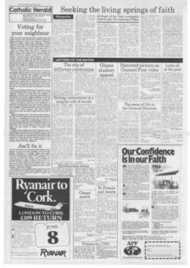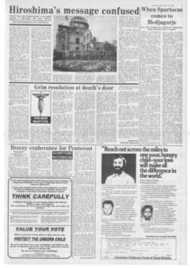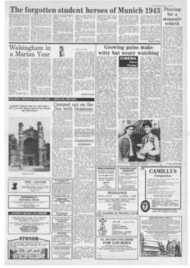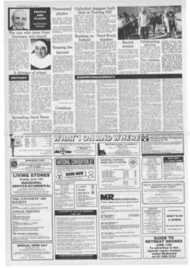Page 7, 5th June 1987
Page 7

Report an error
Noticed an error on this page?If you've noticed an error in this article please click here to report it.
Tags
Share
Related articles
New Life At England's Nazareth
Golden Walsingham
The Year Of The Pilgrim
Pilgrims-gatherlo-commemorate---
Notes For Ransomers
Walsingham in a Marian Year
IN the twelfth century Walsingham was one of the four main shrines in Christendom. It stood alonside Rome, Jerusalem and St James of Compostella in importance and pilgrims flocked in their thousands to this tiny backwater in rural Norfolk.
If England was known as Mary's dowry, then Walsingham was England's Little Nazareth, for here, so the legend goes, in 1061 Our Lady appeared to Richeldis de Faverches, a devout Norman widow and in a vision showed her the house where the Annunciation had taken place, and where the Holy Family had lived. Richeldis was told to take careful note of the dimensions of this little house so she could construct a replica of it in Walsingham.
This she did, and under her directions, carpenters built a tiny little wooden chapel 23 foot 6 inches by 12 foot 10 inches. They had trouble, however, in erecting it on the chosen site, and had to abandon their efforts when night fell. Richeldis prayed for guidance and the following day when the men returned they found not only had the work been completed, but the entire building had been moved to another spot 200 feet away.
As pilgrims began to flock to Walsingham, Geoffrey de Faverches, Richeldis' son, had a priory and a church built, and passed the running of the shrine to the Augustinian canons. The shrine flourished and received many endowments and privileges.
Edward I had a particular devotion to Our Lady of Walsingham, whom he credited with having saved him from death in a near accident as a young man, and he visited the shrine 13 times. In fact every English monarch from Henry III until the Reformation is known to have paid at least one visit to Walsingham. This even included Henry VIII, who was responsible for its eventual destruction. As a young man, he walked barefoot in pilgrimage all the way from Barsham. Erasmus, the great philosopher and theologian came too and recorded his impressions.
The wealth of Walsingham, however, made it a prime target in the Reformation. Although the Augustinian canons signed the Act of Supremacy acknowledging Henry VIII as the head of the Church, the days of the shrine were numbered, and in 1538 the priory and its buildings were sold, and the famous statue of Our Lady of Walsingham was taken to Devotion to Our Lady of Walsingham was outlawed but over the centuries a few pilgrims did continue to come in secret. At the end of the 19th century, Charlotte Boyd, an Anglican convert, bought the disused fourteenth century Slipper Chapel, where in the old days, pilgrims had stopped to remove their shoes so they could walk the final mile to the shrine barefoot. She restored the chapel and donated it to the Benedictines of Downside. They eventually handed it over to the diocese and on August 19, 1934 the first public Mass was celebrated there.
This was a magnificent ceremony presided over by Cardinal Bourne and most of the hierarchy, with 13,000 people, when the chapel was formally consecrated as the National Catholic Shrine to Our Lady.
Kristina Cooper
blog comments powered by Disqus











